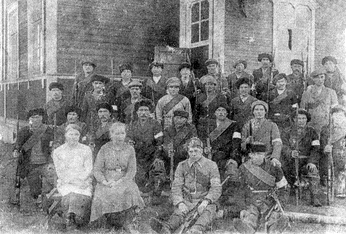The fates of the participants in the Olonets expedition
The Finnish War of Independence finished, the victory parade held in Helsinki and the warriors returned home. In the spring of 1919, lot of youths who did not take part in the war due to age limits, got a chance to take part in the Olonets expedition. Due to the ban on the recruitment of volunteers in the military age to the Olonets expedition, the majority were from 16 to 20 years old, but there were also younger ones. Student youth were well represented, but young workers and peasant sons were also present. Lot of youths made decisions under the influence of peers, regardless of the presence or absence of permission from their parents. The fates of the participants in the Olonets expedition developed by different ways. Lyceum student Yrjö Saarenpuu was, possible innocently, executed by his own side. Another lyceum student – Viljo Heinonen – was captured and remained in obscurity for two years. He became a writer and rector of the Lyceum of Pori. Heinola residents Bruno Schildt and Uuno Salonen (in future – famous Finnish poet Uuno Kailas) were close friends. During the Finnish War of Independence, Bruno fought at the front, but Uuno had stayed home. Therefore, Uuno had not hesitated when in 1919 arose the opportunity take part with Bruno as a volunteers in the Olonets expedition. However, Bruno's mother had persuaded her son not to leave, and Bruno had already canceled his departure when Uuno convinced him that he could not leave. On May 23, 1919, Uuno Salonen, Bruno Schildt and his brother Lasse Schildt left for the Olonets Karelia as part of a group of Finnish volunteers. Youths fought in the 1st Company of the 2nd Battalion of the Regiment under the command of Paavo Talvela. On June 30, 1919, Bruno Schildt disappeared on a patrol trip. Bruno's death was a crushing blow to Uuno, whose memory did not leave him alone for the rest of his life. Even in his last letter written on his deathbed, Uuno Kailas said that he still had dreamed of Bruno Schildt. The guilt that Uuno Kailas felt, was reflected in his autobiographical short story "Bruno is Dead". Then began the Finnish War of Independence, Elias Simelius was a 7th grade student at the Oulu Lyceum. He volunteered for the First Front Squad and marched from Oulu to Pori and Tampere. One year later, without waiting for completion of graduation tests, he, against the will of his parents, went to Olonets Karelia together with his six classmates. During this time, he was planning a military career. But a turning point t in his life took place in the Ulvany Village. Elias Simelius was captured by the Bolsheviks, but managed to escape and jumped off the bridge into the icy water of the Ulvanka River. While swimming, he promised God that if he saves him, he would begin to study theology and forget about military career forever. Elias Simelius returned home and began his studies at the University of Helsinki. Sculptor Victor Jansson chose him as a model for the Freedom Monuments in Tampere and in Lahti, both unveiled in 1921. At the end of 1921 came information from the East Karelia about about the beginning of the uprising and Elias Simelius joined a demolition detail under the command of Reserve Lieutenant Pauli Marttina, whose task was to cut the line of the Murmansk railway (blow up the railway bridge across the Svir River). However, the sabotage failed, and the group had to turn back. In 1922 Elias Simelius and his ideological brothers founded the Academic Karelian Society. In 1923 he graduated from the University of Helsinki and was ordained a priest. In 1926 he changed his last name to Simojoki. Elias Simojoki proved himself as far-right politician and from 1933 to 1939 he was a Member of Parliament for the Patriotic People's Movement party. When the Winter War broke out Elias Simojoki volunteered for the front-line. He became military chaplain of the 39th Infantry Regiment. His life was cut short on the ice of Lake Ladoga in the Bay of Koirinoja. He went to a no-man's land putting down a wounded Red Army horse, shot it and already turned back when he was mown down by an enemy machine gun. Ilmari Rytkönen also took part in the Finnish War of Independence, he fought in Vilppula and Lempäälä, then in Savo and in the Lahti region. At the spring of 1918 he graduated from Hämeenlinna Lyceum and at the autumn began his studies in the Higher School of Commerce, but already in January 1919 he went to the Estonian War of Independence as a platoon commander. On January 31, 1919, he took part in the Battle of Paju manor near the city of Valga and was seriously wounded by enemy machine gun fire. In the same battle the legendary hero of the Estonian War of Independence Julius Kuperjanov was mortally wounded. Nevertheless, already in May 1919, Ilmari Rytkönen was ready to go on the Olonets expedition as a company commander in the volunteer Tavastia battalion. In mid-June, in Olonets Karelia, he got a bullet in his leg. After the end of the Kinship Wars, Ilmari Rytkönen became a career officer, he took part in the Winter War, the Continuation War and the Lapland War. In the summer of 1944, Lieutenant Colonel Rytkönen was the commander of the 44th Infantry Regiment. In fierce battles in the Pitkäranta-Nietjärvi direction, his regiment stopped a massive attack of Soviet troops and stabilized the front-line until the end of the war. At 1943 in Äänislinna (conquered Petrozavodsk) were renamed a lot of streets. Among the new names were Kailaankatu (Kailas Street), Simojoenkatu (Simojoki Street) and Heimosoturinkatu (Kinship Warrior Street). |